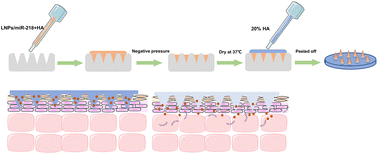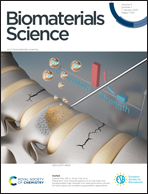A lipid–polymer hybrid nanoparticle (LPN)-loaded dissolving microneedle patch for promoting hair regrowth by transdermal miR-218 delivery†
Abstract
Alopecia is the most common multifactorial hair loss disorder, affecting almost 50% of the population and even having a serious psychological impact on the patients. miR-218 has therapeutic potential for alopecia since it can activate the Wnt/β-catenin channel by down-regulating SFRP2, which is a key channel in hair follicle cycle transformation for hair regrowth. Although miR-218 has the potential to treat this disease, several barrier properties of the skin challenge miRNA's delivery to the target location, such as passing through the corneum and resistant enzymatic degradation. To address these challenges, we evaluated a device that combined the use of hyaluronic acid (HA)-based dissolving microneedle (MN) to enhance corneum permeability with the lipid polymer hybrid nanoparticles (LPNs) as a miRNA delivery carrier to protect miR-218 from degradation. The MN patches could promote LPNs/miR-218 diffusing in the dermis region, and significantly increase the bioavailability of miR-218. Furthermore, in the shaved mouse model, the MN patches showed higher efficacy in promoting hair growth than the topical smear treatment, while avoiding the safety concern. This work established a novel and effective combination device with MN and LPNs that can be used for localized transdermal miRNA delivery to promote hair regrowth.

- This article is part of the themed collection: Microneedles


 Please wait while we load your content...
Please wait while we load your content...